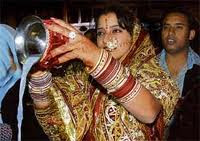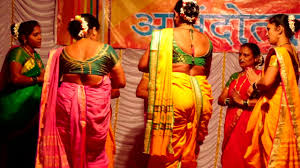Karva Chauth and Social Significance





Karva Chauth is an annual one-day festival observed and celebrated by Hindu and Punjabi women in North India wherein married women fast from sunrise to onset of the moon.
This is observed for the safety and longevity of their husbands.
Karva is another word for diya (a small earthen oil-lamp) and chauth means 'fourth' in Hindi (a reference to the fact that the festival falls on the fourth day of the dark-fortnight, or krishna paksh, of the month of Kartik of Hindu calendar usually it falls in October month. This karva Chauth fast is of particular importance to all Hindu married women in India. It is believed that the festival ensures wealth, endurance and happiness of their husbands. Karwa Chauth generally falls on the full moon day of the month Jyeshtha. This is also known as 'Vata Purnima'
This festival is celebrated in large gatherings in full swing in almost all the states of North India like : Uttarakhand, Uttar Pradesh, Himachal Pradesh, Haryana, Punjab, Rajasthan and Gujarat. Again, north Indian settlers in south India also celebrate it in fullest spirit. Modern days, unmarried women observe the fast for their fiancés or desired husbands.
The preparation for Karva Chauth begins a few days in advance, these days it has become a kind of fashion in displaying more of cosmetics, ornaments or jewelry, than understanding its significance behind.
There are numerous stories and legends behind Karva Chauth. Some of them are listed below.
The Story of Queen Veeravati
A long long time ago, there lived a beautiful girl by the name of Veeravati. She was the only sister of her seven loving brothers, who was married to a king. On the occasion of the first Karva Chauth after her marriage, she went to her parents' house. After sunrise, she observed a strict fast. However, the queen couldn't stand the rigors of fasting and was desperately waiting for the moon to rise. The seven brothers, who loved her dearly, were very disturbed watching the distress of their sister and decided to end her fast by deceiving her. Then the brothers reflected a mirror through Pipal tree leaves. The sister, taken it as moon rise, broke the fast and took food. However, the moment the queen ate her dinner, she received the news that her husband, the king, was seriously ill.
The Queen rushed to her husband's palace and on the way, and saw that the king had died. She prayed to Lord Shiva and his consort, Goddess Parvati. Parvati informed her that the king had died because the queen had broken her fast by watching a false moon. However, when the queen asked her for forgiveness, the goddess granted her the boon that the king would be revived. But to achieve this, she would have to undertake the Karva Chauth fast under strict rituals, and then only her husband would come to life. Thus, by strictly following all the rituals of Karva chauth, Queen Veeravati enlivened her husband.
The Legend of Mahabharata
The belief in this fast and its associated rituals goes back to the pre-Mahabharata times. Draupadi, too, is said to have observed this fast. Once during their exile Pandavas faced many problems. Draupadi, out of desperation, remembered Lord Krishna and asked for help. Lord Krishna reminded her that on an earlier occasion, when Goddess Parvati had sought Lord Shivas guidance under similar circumstances, she had been advised to observe the fast of Karva Chauth. Draupadi followed the instructions and observed the fast with all its rituals. Consequently, the Pandavas were able to overcome their problems. On this day, fasting women listen to Karva Chauth legends with rapt attention.
The Story of Satyavan and Savitri
There is the story of the Satyavan and Savitri. When Lord Yama, came to procure Satyavan's soul, Savitri begged him to grant him life. When he refused, she stopped eating and drinking and Yamraj finally relented. He granted her, her husband's life. To this day, Karva Chauth is celebrated with great faith and belief.
Significance of Karva Chauth
In olden days, girls were married at a very early stage, and had to go and live with their in-laws in other villages or towns. After marriage, her husband’s house was everything for her. As in those days the communication advances was also not developed as that of modern day. Absence and no access to telephones, buses and trains, it was difficult for married girls to approach her parents even during difficulties. Her own parents and relatives would be quite far and unreachable. Thus the custom started that; this married girl would befriend another woman or women at the time of marriage, who would be her friend or sister for life. Their friendship would be sanctified through a small Hindu ceremony right during the marriage. This gave scope to the married girls to speak confidently and sharing their difficulties and happiness. Thus, Karwa Chauth was started to as a festival to celebrate this relationship between the once-brides and their good-friends. Fasting and praying for husband came later and is secondary. It was probably added, along with other mythical tales, to enhance the festival.
The festival of Karwa chauth is one of the most important festivals for married women in North India. A few days before this auspicious festival, all the markets get flooded with various accessories and decorative items including bangles, beautiful sarees, embroidered suits, stalls of sweets and eatables. A number of artists from different cities like Agra, Jaipur, Delhi, etc gathers with their special mehndis to decorate the hands of women.
In some part of north India, women make the karwas with mud and fill them with rice and wheat. They wear their wedding-day dress or chunris or duppata on this auspicious day. It is also believed that the woman who observes this fast is not only blessed with welfare of her husband but also wins the same husband for the next seven births (Unless until she is not fed up with her husband for this birth and wish to have him for the remaining births too).
On this day the women get up before sunrise. They worship Shiva, Parvati, Ganesh, Kartikeya and the moon. The blessings of the Gods are invoked for longevity and prosperity of their husbands and children. Mothers-in-law give their daughters-in-law sumptuous food called 'Sargi' to eat before sunrise, as the fast starts before sunrise and ends only after worshiping the moon at night. It is a tough fast, as the women do not take any food or even a sip of water.
In the evening, the women adorn in bridal ceremonial dress. Many times, the newly wed wear their wedding dress for this auspicious occasion, usually the ghagra-choli or Banarsi saris, embellished with the old-new shimmer of gold, diamonds and rubies. After dressing up, she receives gifts from the mother-in-law.
Before evening, the married woman receives the baya or a basket full of goodies from her mother, which is meant for the mother-in-law. The basket contains sweets, mathadi, fruits and a sari. Before the sun sets, most of the women in a locality gather in one house and prepare a corner for the puja. This puja chowk is beautifully decorated and a small platform is prepared against a wall. On this, the image of Gauri Mata or Goddess Parvati is placed. In the olden days, this image was made of cow-dung and haldi paste.
The women sit around this image with their bayas. Each woman also places a karva or a pitcher full of water and seven pieces of bua. (Seven broken from one bigpua). The karva itself is dee with kharia, aipun and a little roli. A red thread is tied around the karva. At the beginning of the puja, women apply the (roli teeka) vermillion mark to Goddess Gauri and also to themselves. With the thumb and the third finger of the right hand, water is sprinkled on the image of the goddess. The same procedure is repeated with aipun and roli. Lastly, rice is showered on the image.
An elderly woman of the family narrates the legend of Karva Chauth. Even a widow can narrate this story. The women then pray for the long life and the welfare of their husbands. While chanting the prayers, they pass their bayas from one to another. The wait for the moon rise begins after sunset, and as soon as the moon is sighted, prayers are offered to the moon. The fasting women first observe the moon through a sieve and then break their fast. The first sip of water and the first morsel of food is offered by the husbands. A sumptuous dinner follows.
Similar to Karva Chauh, in Tamil Nadu, women observe Karadayan Nonbu and celebrate in the month of Maasi, when the month of Maasi ends and the month of Panguni begins. This festival is celebrated to obtain the Deerga Soumangalyam. It is often said that "Maasi Kayaru, Paasi Padiyum" - which means, it will last long. Karadaiyan Nonbu is done on the praise of Parvathi, who remains with her husband Shiva in the form of Arthanarreshwara. All women wish to have a long life with their husband. Many women during this Vrat, fast from early in the morning and complete the Vrat at the time of Sankaramanam by offering the Adai's made to the Goddess along with a lump of butter.
Likewise, Bhima Ammavasa, also known as Jyoti Bheemeshwara Vratam, is an important Hindu ritual performed by women in Karnataka. Bheemana Amavasi is observed on the Ammavasai, no moon day, in the Kannada month of Ashada (July – August). It is the last day of the month of Aashada. Women pray for the well being of their husbands and brothers on this day.
Jyoti Bheemeshwara Ammavasi is dedicated to Lord Shiva and Goddess Parvati. Married and unmarried women and girls pray on this day for the welfare, happiness and long life of husbands, brothers and other males in the house. Thambittu Deepa or Thembittu lamp made from flour is made on the occasion and lit to cool all bad emotions like anger etc. A pair of lamps made using mud known as Kalikamba represents Shiva and Parvati on the day. Special pujas are done on the auspicious day to appease the divine couple.
Another important feature is the making of Kadubu. Dough balls, or Kadubus, have coins hidden in them. Coins are also hidden in idli, kozhakattai, modak and wheat balls. These balls are smashed by brothers or young boys at the end of the Puja.
The ritual is based on the story of a young girl who was married to a dead prince. She accepted her faith and the day after marriage she performed the Bheemana Amavasya puja with mud lamps. Impressed by her devotion Shiva and Parvati appeared before her and brought back the prince to life. The mud kadubu prepared by her was broken by Lord Shiva.
It is the modern times; Bollywood movies have popularized this Karva Chauch as a symbol of Love and welfare. More films made in the 70s and 80s did show case a scene of Karva Chauth. In recent times, films like Dilwale Dulhania Le Jayenge (DDLJ) and Baghban have made it more of a gala affair.
One gets to hear about celebrities observing the vrat and this highlights the keeping of the fast by an unmarried female public figure because it indicates a strong and likely-permanent romantic attachment.
All said and done, it is good to see that the tradition is passed from one generation to the other. Hope the significance and importance is also passed.










Comments